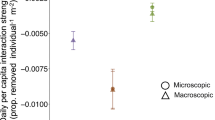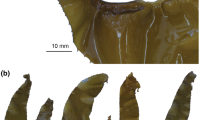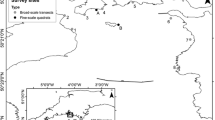Summary
The odacid fish Odax cyanomelas feeds on the kelp Ecklonia radiata, an important component of subtidal reef habitats on the central coast of New South Wales, Australia. Herbivory by Odax has a major impact on the structure and dynamics of discrete patches within larger stands of kelp at Cape Banks. This three-year study showed that each year, between August and October, approximately the same patches of kelp were denuded by preferential feeding on the meristem and primary laminae. This coincided with a variable pulse of Ecklonia recruits to the cleared patches, thereby generating patches of a single age-class of plants. Neighbouring areas of Ecklonia forest, non cleared by Odax, consisted of larger, perennial plants, which exhibited more gradual changes in abundance. The seasonal impact of Odax appeared to be due to a change in the behaviour of female Odax during their spawning period. Observations suggested that females aggregate at traditional sites prior to spawning with territorial males in adjacent areas of kelp forest. An alternative hypothesis, that Odax preferentially attacked stands of one-year old Ecklonia plants, was rejected by a field experiment; the establishment of experimental stands of one-year old plants did not lead to increased damage due to Odax or any change in the use of space by the fish. The generality of this effect of fish herbivory is unknown, but this and other Odax species are widely distributed throughout temperate Australia, where Ecklonia is the dominant laminarian alga. The effects of pulsed herbivory by Odax is contrasted to the more continuous grazing by sea urchins in the same system. The latter herbivore has been shown to maintain areas free of Ecklonia, the long-term effects of herbivory by Odax remain unclear.
Similar content being viewed by others
References
Andrew NL (1988) Population dynamics and herbivory in the common sea urchin Centrostephanus rodgersii, Ph.D. Thesis, University of Sydney, p 148
Andrew NL, Choat JH (1982) The influence of predation and conspecific adults on the survivorship of juvenile Evechinus chloroticus (Echinoidea: Echinometridae). Oecologia 54:80–87
Andrew NL, Underwood AJ (1989) Patterns of abundance in the sea urchin Centrostephanus rodgersii on the central coast of New South Wales, Australia. J Exp Mar Biol Ecol 131:61–80
Atkinson WD, Shorrocks B (1981) Competition for a divided and ephemeral resource: a simulation model. J Anim Ecol 50:461–471
Auerbach M, Shmida A (1987) Spatial scale and the determinants of plant species richness. TREE 2:238–242
Bodkin JL (1988) Effects of kelp forest removal on associated fish assemblages in central California. J Exp Mar Biol Ecol 117:227–238
Carpenter RC (1986) Partitioning herbivory and its effects on coral reef algal communities. Ecol Monogr 56:345–363
Carr MH (1989) Effects of macroalgal assemblages on the recruitment of temperate zone reef fishes. J Exp Mar Biol Ecol 126:59–76
Chapman ARO (1981) Stability of sea urchin dominated barren grounds following destructive grazing of kelp in St. Margaret's Bay, eastern Canada. Mar Biol 62:307–311
Choat JH (1982) Fish feeding and the structure of benthic communities in temperate waters. Ann Rev Ecol Syst 13:423–449
Choat JH, Ayling AM (1987) The relationship between habitat structure and fish faunas on New Zealand reefs. J Exp Mar Biol Ecol 110:257–284
Choat JH, Bellwood DR (1985) Interactions among herbivorous fishes on a coral reef: influence of spatial variation. Mar Biol 89:221–234
Connell JH, Keough MJ (1985) Disturbance and patch dynamics of subtidal marine animals on hard substrata. In: Pickett STA, White PS (eds) The ecology of natural disturbance and patch dynamics. Academic Press, New York, pp 125–151
Cowen RK, Agegian CR, Foster MS (1982) The maintenance of community structure in a central California giant kelp forest. J Exp Mar Biol Ecol 64:189–201
Day RW, Quinn GP (1989) Comparisons of means after an analysis of variance in ecology. Ecol Monogr 59:433–463
Dayton PK (1973) Dispersion, dispersal and persistence of the annual intertidal alga Postelsia palmaeformis Ruprecht. Ecology 54:433–438
Dayton PK (1985) Ecology of kelp communities. Ann Rev Ecol Syst 16:215–245
Dayton PK, Currie V, Gerrodette T, Keller BD, Rosenthal R, Ven Tresca D (1984) Patch dynamics and stability of some California kelp communities. Ecol Monogr 54:253–289
Dayton PK, Tegner MJ (1984) The importance of scale in community ecology: a kelp forest example with terrestrial analogs. In: Price PW, Slobodchikoff CN, Gaud WS (eds). A new ecology: novel approaches to interactive systems. John Wiley & Sons, New York, pp 457–481
Deysher L, Norton TA (1982) Dispersal and colonization in Sargassum muticum. J Exp Mar Biol Ecol 56:179–195
Ebeling AW, Laur DR, Rowley RJ (1985) Severe storm disturbances and reversal of community structure in a southern California kelp forest. Mar Biol 84:287–294
Fletcher WJ (1987) Interactions among subtidal Australian sea urchins, gastropods, and algae: effects of experimental removals. Ecol Monogr 57:89–109
Gaines SD (1985) Herbivory and between-habitat diversity: the differential effectiveness of defenses in a marine plant. Ecology 66:43–485
Geiselman JA, McConnell OJ (1981) Polyphenols in the brown algae Fucus vesiculosus and Ascophyllum nodosum: chemical defense against the herbivorous snail Littorina littorea J Chem Ecol 7:1115–1133
Gomon MF, Paxton JR (1985) A revision of the Odacidae, a temperate Australian-New Zealand labroid fish family. Indo-Pacific Fishes 8:1–57
Harris LG, Ebeling AW, Laur DR, Rowley RJ (1984) Community recovery after storm damage: a case of facilitation in primary succession. Science 224:1336–1338
Harrold C, Reed DC (19857 Food availability), sea urchin grazing, and kelp forest community structure. Ecology 66:1160–1169
Hay ME (1981) Herbivory, algal distribution, and the maintenance of between-habitat diversity on a tropical fringing reef. Am Nat 118:520–540
Hay ME (1984) Patterns of fish and urchin grazing on Caribbean coral reefs: are previous results typical? Ecology 65:446–454
Hay ME, Fenical W (1988) Marine plant-herbivore interactions: the ecology of chemical defense. Ann Rev Ecol Syst 19:111–145
Hay ME, Fenical W, Gustafson K (1987) Chemical defense against diverse coralreef herbivores. Ecology 68:1581–1591
Heck KL Jr, Orth RJ (1980) Seagrass habitats: the roles of habitat complexity, competition and predation in structuring associated fish and motile macroinvertebrate assemblages. In: Kennedy VS (ed) Estuarine perspectives. Academic Press, New York, pp 449–464
Holbrook SJ, Schmitt RJ (1988) Effects of predation risk and foraging behaviour: mechanisms altering patch choise. J Exp Mar Biol Ecol 121:151–163
Horn MH (1983) Optimal diets in complex environments: feeding strategies of two herbivorous fishes from a temperate intertidal zone. Oecologia 58:345–350
Johnson CR, Mann KH (1986) The importance of plant defence abilities to the structure of subtidal seaweed communities: the kelp Laminaria longicruris de la Pylaie survives grazing by the snail Lacuna vincta (Montagu) at high population densities. J Exp Mar Biol Ecol 97:231–267
Johnson CR, Mann KH (1988) Diversity, patterns of adaptation and stability of Nova Scotian kelp beds. Ecol Monogr 58:129–154
Jones GP (1984) Population ecology of a temperate reef fish Pseudolabrus celidotus Bloch and Schneider (Pisces: Lartidae) I. Factors affecting recruitment. J Exp Mar Biol Ecol 75:257–276
Jones GP (1988) Ecology of rocky reef fishes of north-eastern New Zealand: a review. NZ J Mar Freshwat Res 22:445–462
Kennelly SJ (1987a) Inhibition of kelp recruitment by turfing algae and consequences for an Australian kelp community. J Exp Mar Biol Ecol 112:49–60
Kennelly SJ (1987b) Physical disturbances in an Australian kelp community. I. Temporal effects. Mar Ecol Prog Ser 40:145–153
Kennelly SJ (1987c) Physical disturbances in an Australian kelp community. II. Effects on understorey species due to differences in kelp cover. Mar Ecol Prog Ser 40:155–165
Keough MJ (1984) Effects of patch size on the abundance of sessile marine invertebrates. Ecology 65:423–437
Lewis SM (1986) The role of herbivorous fishes in the organization of a Caribbeasn reef community. Ecol Monogr 56:183–200
Lubchenco J, Gaines SD (1981) A unified approach to marine plant-herbivore interactions. I. Populations and communities. Ann Rev Ecol Syst 12:405–437
Morris DW (1987) Ecological scale and habitat use. Ecology 68:362–369
Paine RT (1979) Disaster, catastrophe and local persistence of the sea palm Postelsia palmaeformis. Science 205:685–687
Paine RT, Levin SA (1981) Intertidal landscapes: distrubance and the dynamics of pattern. Ecol Monogr 51:145–178
Peterson CH (1982) Clam predation by whelkes (Busycon spp.): Experimental tests of the importance of prey size, prey density, and seagrass cover. Mar Biol 66:159–170
Pickett STA, White PS (1985) The ecology of natural disturbance and patch dynamics. Academic Press, New York
Ragan MA, Jensen A (1977) Quantitative studies on brown algal polyphenols. I. Estimation of absolute polyphenol content of Ascophyllum nodosum (L.) and Fucus vesiculosus (L.). J Exp Mar Biol Ecol 34:245–258
Reed DC, Foster MS (1984) The effects of canopy shading on algal recruitment and growth in a giant kelp forest. Ecology 65:937–948
Reed DC, Laur DR, Ebeling AW (1988) Variation in algal recruitment: the importance of episodic events. Ecology 58:321–335
Ricklefs RE (1977) Environmental heterogeneity and plant-species diversity: a hypothesis. Am Nat 111:376–381
Sammarco PW (1983) Effects of fish grazing and damselfish territoriality on coral reef algae. I. Algal community structure. Mar Ecol Prog Ser 13:1–14
Schiel DR (1985) Growth, survival and reproduction of two species of marine algae at different densities in natural stands. J Ecol 73:199–217
Schiel DR (1988) Algal interactions on shallow subtidal reefs in northern New Zealand: a review. NZ J Mar Freshwat Res 22:481–489
Schiel DR, Foster MS (1986) The structure of subtidal algal stands in temperate waters. Oceanogr Mar Biol Annu Rev 24:265–307
Scott FJ, Russ GR (1987) Effects of grazing on species composition of the elipthic algal community on coral reefs of the central Great Barrier Reef. Mar Ecol Prog Ser 39:293–304
Sousa WP (1984) The role of disturbance in natural communities. Ann Rev Ecol Syst 15:353–391
Sousa WP (1985) Disturbance and patch dynamics on rocky intertidal shores. In: Pickett STA, White PS (eds) The ecology of natural disturbance and patch dynamics. Academic Press, New York, pp 101–124
Steinberg PD (1984) Algal chemical defense against herbivores: Allocation of phenolic compounds in the kelp Alaria marginata. Science 223:405–407
Steinberg PD (1986) Chemical defenses and the susceptibility of tropical marine brown algae to herbivores. Oecologia 69:628–630
Targett NM, Targett TE, Vrolijk NH, Ogden JC (1986) Effect of macrophyte secondary metabolites on feeding preferences of the herbivorous parrotfish Sparisoma radians Mar Biol 92:141–148
Tonn WM, Magnuson JJ (1982) Patterns in the species composition and richness of fish assemblages in northern Wisconsin lakes. Ecology 63:1149–1166
Wiens JA (1985) Vertebrate responses to environmental patchiness in arid and semi-arid ecosystems. In: Pickett STA, White PS (eds) The ecology of natural disturbance and patch dynamics. Academic Press, New York, pp 169–193
Wiens JA, Rotenberry JT (1981) Habitat associations and community structure of birds in shrubsteppe environments. Ecol Monogr 51:21–41
Winer BJ (1971) Statistical principles in experimental design. McGraw-Hill, Kogakusha, Tokyo
Author information
Authors and Affiliations
Rights and permissions
About this article
Cite this article
Andrew, N.L., Jones, G.P. Patch formation by herbivorous fish in a temperate Australian kelp forest. Oecologia 85, 57–68 (1990). https://doi.org/10.1007/BF00317343
Received:
Accepted:
Issue Date:
DOI: https://doi.org/10.1007/BF00317343




